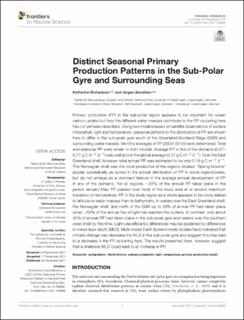| dc.contributor.author | Richardson, Katherine | |
| dc.contributor.author | Bendtsen, Jørgen | |
| dc.date.accessioned | 2022-01-18T12:42:23Z | |
| dc.date.available | 2022-01-18T12:42:23Z | |
| dc.date.created | 2021-12-13T15:29:33Z | |
| dc.date.issued | 2021 | |
| dc.identifier.citation | Frontiers in Marine Science. 2021, 8, 785685. | en_US |
| dc.identifier.issn | 2296-7745 | |
| dc.identifier.uri | https://hdl.handle.net/11250/2837941 | |
| dc.description.abstract | Primary production (PP) in the sub-polar region appears to be important for ocean carbon uptake but how the different water masses contribute to the PP occurring here has not yet been described. Using two models based on satellite observations of surface chlorophyll, light and temperature, seasonal patterns in the distribution of PP are shown here to differ in the sub-polar gyre south of the Greenland-Scotland Ridge (GSR) and surrounding water masses. Monthly averages of PP (2003–2013) were determined. Total and seasonal PP were similar in both models. Average PP in five of the domains (0.47–0.77 g C m–2 d–1) was well above the global average (0.37 g C m–2 d–1). Over the East Greenland shelf, however, total annual PP was estimated to be only 0.19 g C m–2 d–1. The Norwegian shelf was the most productive of the regions studied. “Spring blooms” appear sporadically as spikes in the annual distribution of PP in some regions/years, but do not emerge as a dominant feature in the average annual development of PP in any of the domains. For all regions, ∼25% of the annual PP takes place in the period January-May. PP peaked over most of the study area at or around maximum insolation or temperature. PP in the study region as a whole appears to be more related to latitude or water masses than to bathymetry. In waters over the East Greenland shelf, the Norwegian shelf, and north of the GSR up to 50% of annual PP had taken place when ∼50% of the annual flux of light has reached the surface. In contrast, only about 35% of annual PP had taken place in the sub-polar gyre and waters over the southern open shelf by this time. Light-use efficiency differences may be explained by differences in mixed layer depth (MLD). Multi-model Earth System model studies have indicated that climate change may decrease the MLD in the sub-polar gyre and suggest this may lead to a decrease in the PP occurring here. The results presented here, however, suggest that a shallower MLD could lead to an increase in PP. | en_US |
| dc.language.iso | eng | en_US |
| dc.publisher | Frontiers | en_US |
| dc.rights | Navngivelse 4.0 Internasjonal | * |
| dc.rights.uri | http://creativecommons.org/licenses/by/4.0/deed.no | * |
| dc.title | Distinct Seasonal Primary Production Patterns in the Sub-Polar Gyre and Surrounding Seas | en_US |
| dc.type | Peer reviewed | en_US |
| dc.type | Journal article | en_US |
| dc.description.version | publishedVersion | en_US |
| dc.rights.holder | Copyright © 2021 Richardson and Bendtsen. | en_US |
| dc.source.pagenumber | 14 | en_US |
| dc.source.volume | 8 | en_US |
| dc.source.journal | Frontiers in Marine Science | en_US |
| dc.identifier.doi | 10.3389/fmars.2021.785685 | |
| dc.identifier.cristin | 1967871 | |
| dc.relation.project | EC/H2020/869383 | en_US |
| dc.source.articlenumber | 785685 | en_US |
| cristin.ispublished | true | |
| cristin.fulltext | original | |
| cristin.qualitycode | 1 | |

